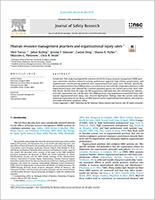On Research: Management’s impact on safety
Journal of Safety Research contributors talk about their work

What’s your study about?
This study looks at human resource management practices – the way that organizations select, recruit, train and design work – and how they’re related to organizational injury rates. In that way, it’s a different angle on what organizations can do to affect safety. The usual way is just thinking about engineering or labor inspections. This study doesn’t test this, but it looks at how this set of practices correlates with injury rates.
What drove your interest in studying this topic?
Well, this study is a really long-standing one. It’s something I actually started about 20 years ago when I lived in the United Kingdom. My doctoral supervisor who is on this paper, Sharon Parker, and Julian Barling from Queen’s University in Canada both had encouraged me to have an interest in workplace safety. And so, over the years we managed to find a data set that would look at HR practices and tie those practices to injury rates held by the [UK’s] Health and Safety Executive.
What are the biggest takeaways from the study?
For workers, the message is the way the organization manages seems to have an effect on workplace safety, which I know isn’t too revelatory to many of us. But I think when primary prevention sometimes gets confused with ramping up labor and safety inspections or following the law or these other things, it provides, I think, a much more sort of active way of seeing how organizations can affect safety. So for employees, the findings from this study show that all of these practices we looked at, that empowerment – this designing work in a way that employees have control over how they do their work, the timing, the method – seems to be the practice that is most related to safety. So, it’s an interesting indicator that the way organizations manage can have a beneficial effect for both safety and performance. I think sometimes safety and performance are considered to be sort of in contrast or antithetical to one another.
What, if anything, surprised you about the results?
One would be that the types of HR practices that relate to performance also relate to better safety, which is an encouraging message. And also, it was neat to be able to set up all of these factors in essentially a competition and see when they all coexist – which is what they do in real-life organizations – which ones sort of came out. It sends a fairly clear message to organizations about what they could do to improve safety.
Did this study have limitations?
This is based on a relatively small sample of organizations. The way this data was collected involved quite intensive, in-dependent audits of these practices. So, I think the data quality is very high, but the sample is necessarily small. The types of organizations we looked at were sort of manufacturing, heavy manufacturing. So the extent to which these findings would play out for, say, service organizations or those in other industries, we don’t know from this study.
Post a comment to this article
Safety+Health welcomes comments that promote respectful dialogue. Please stay on topic. Comments that contain personal attacks, profanity or abusive language – or those aggressively promoting products or services – will be removed. We reserve the right to determine which comments violate our comment policy. (Anonymous comments are welcome; merely skip the “name” field in the comment box. An email address is required but will not be included with your comment.)


